Found in California’s beautiful Napa County, Lake Berryessa is a man-made lake created when the Monticello dam was built between the years 1953 and 1957. The lake provides hydroelectric power to part of the San Francisco Bay Area and is also full of and surrounded by diverse flora and fauna. These include snakes, a couple of which are venomous. Here are eight snakes that you might find around Lake Berryessa.
1. Gopher Snake
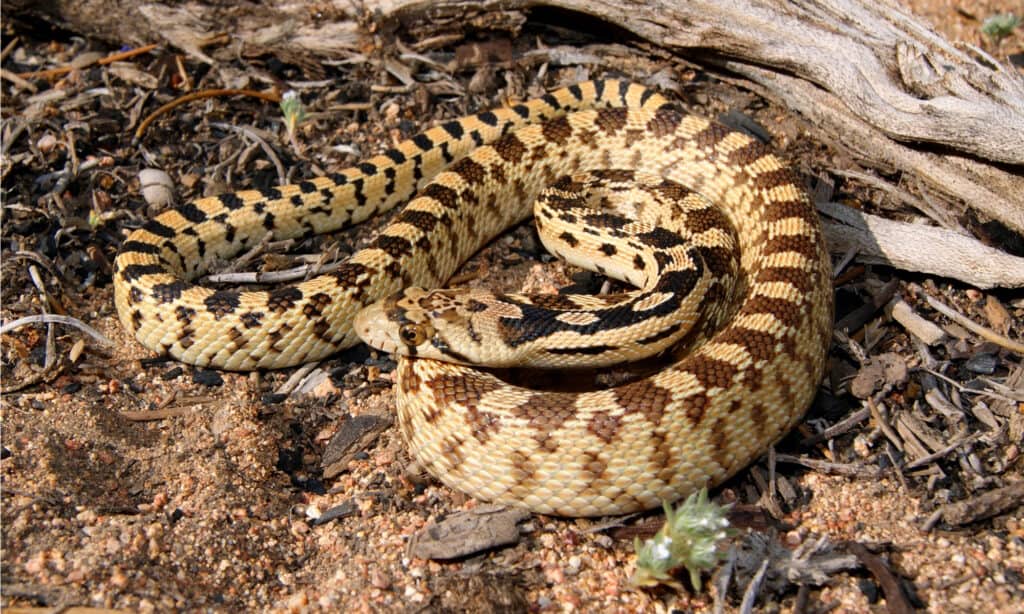
The gopher snake is a type of bull snake.
©Matt Jeppson/Shutterstock.com
A heavy bodied, nonvenomous snake, the gopher snake a kind of bull snake found on the west coast of North America, from British Columbia down to Mexico. You’ll most likely find it in open areas around the lake.
What It Looks Like
The gopher snake ranges in length from 5.9 to 9 feet. It’s notable for its large head, large eyes, and thin neck. The coloration of the snakes that live around the lake blends in with the coloration of the terrain, so the snake’s body can have a ground color of gray to yellowish brown with stripes or blotches. The snake’s scales are keeled, and the reptile looks quite like a rattlesnake. Though the gopher snake lacks a rattle and is nonvenomous, it can still deliver a nasty bite.
What It Eats
Gopher snakes eat smaller mammals, including gophers. It also takes insects, eggs, birds, and other reptiles. It kills them by constriction then swallows them whole. The snake has no problem entering burrows to look for prey and has even been known to hunt bats where they roost. On the other hand, gopher snakes, especially young ones, are preyed on by foxes, hawks, larger snakes, and coyotes.
Behavior and Reproduction
These snakes, whose scientific name is Pituophis catenifer, are solitary, active mostly during the day, and live in dens or burrows. They are good swimmers and climbers and go into dormancy when they’re at rest or when food is scarce. Gopher snakes only get together to breed, and that happens once a year during the summer. Females lay two to 24 eggs per clutch, and they hatch after 65 to 75 days. When the eggs hatch, the hatchlings are on their own.
A female gopher snake is ready to mate when she’s around four years old, while a male is ready when he’s only a year and a half. Gopher snakes usually live between 12 and 15 years, though at least one captive snake lived to be 33. The gopher snake’s conservation status is least concern.
2. Ring-necked Snake
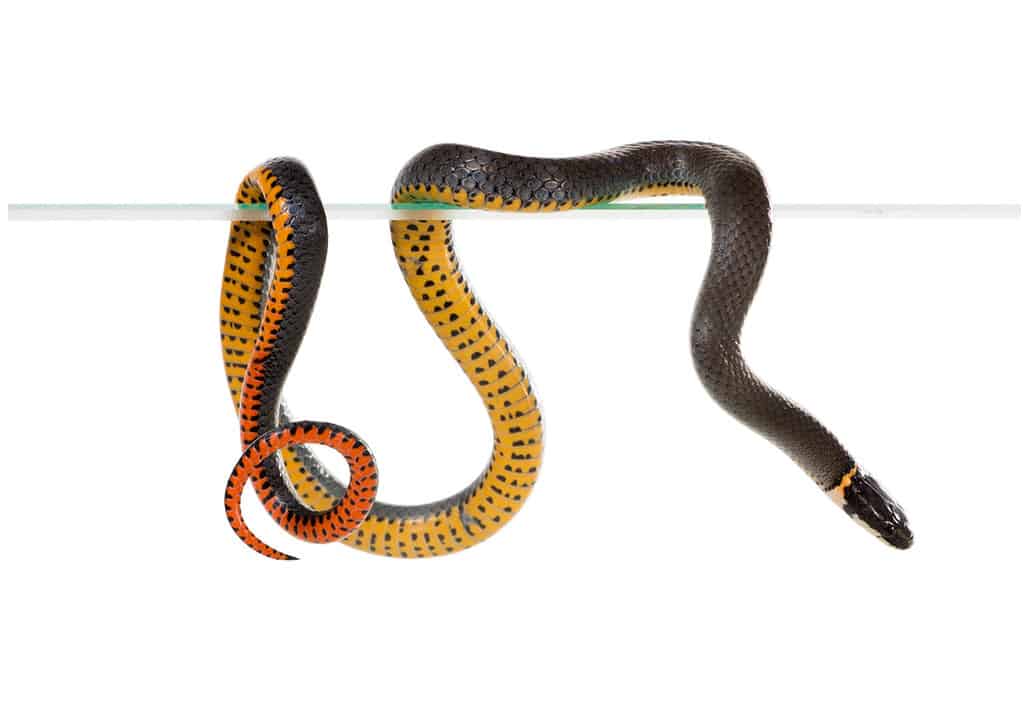
The ringneck snake is unusual because it’s active at night.
©IrinaK/Shutterstock.com
Diadophis punctatus, the ringneck or ring-necked snake, is a common but secretive snake that’s active at night. They are famous for curling up their tails and exposing the brilliantly orange red underside when they’re threatened. The top, or dorsal part of the snake ranges from olive green, blue-gray, black, or brown. The color is broken by a band around the neck that can be red, yellow, or yellow-orange. The snake’s head is also a little darker than the rest of its body. The bright colors of the snake’s ventral side is broken up by black spots. The way these spots are arranged on the snake’s belly can tell you which subspecies it belongs to. The ringneck is a small snake and is usually only 10 to 15 inches long. Female snakes are longer than males.
Behavior
Though ringneck snakes are hard to find, they are actually quite social animals and gather in colonies that can hold 100 or more animals. They communicate with each other through touch and the release of pheromones, especially during the mating season. These snakes eat the smaller kinds of frogs, earthworms, salamanders, lizards, and baby snakes. As a nonvenomous constrictor, the ringneck snake squeezes its prey to death then swallows it whole.
Reproduction
Ringneck snakes mate during spring and fall, and females lay three to 10 eggs in midsummer. Females who mated in the fall can delay fertilization of their eggs. Because ringneck snakes are social, females often use communal nests. The hatchlings emerge in late summer and are on their own immediately. Because of this, a good percentage of ringneck hatchlings don’t survive to adulthood. If they do, they’ll be ready to mate when they’re about three years old. Ringneck snakes live about 10 years, and their conservation status is least concern.
3. Garter Snake (Sort of Venomous)

Scientists didn’t know until recently that garters snakes are venomous. They are harmless to humans, though.
©iStock.com/rkhalil
Garter snakes belong to a large genus of small or mid-sized snakes. There are about 35 species, and around Lake Berryessa you might find the Sierra garter snake, the northwestern garter snake, the western ribbon snake, or the common garter snake. Interestingly, garter snakes were once believed to be nonvenomous. It turns out they are venomous, but their venom is so weak it doesn’t injure human beings.
What Garter Snakes Look Like
These snakes are slender, with large eyes with round pupils, and keeled scales. Most have stripes down the length of their bodies. These stripes can be neutral colored or come in bright colors of red, blue, or yellow. Some garter snakes lack stripes and are completely black. Most are 18 to 51 inches long and weigh about 5.29 ounces. Females are longer than males. Though garter snakes can thrive in a variety of habitats, they’re never far from water, and you should be able to easily find them around Lake Berryessa.
Garter snakes are diurnal and can stay active when the temperatures grow too cool for other snakes. They often hibernate from October to March or April, but on warmer days they’ll come out to bask. Garter snakes use the abandoned burrows of rodents or crayfish to hibernate, though some can be found under rocks. Though these snakes are mostly solitary, they’ll come together to hibernate and keep each other warm.
What Garter Snakes Eat
A garter snake eats amphibians, smaller snakes, smaller fish and invertebrates such as earthworms and insects. Now and then they’ll eat eggs. The poisons in the skin of toads doesn’t affect them, and they can store the poison in their own liver. This makes the garter snake toxic to an animal that wants to eat it, and many animals like to eat garter snakes. These include larger reptiles and amphibians, birds, foxes, squirrels and raccoons. The garter snake’s patterns and colors help camouflage it, and it will take to the water to escape a predator.
Reproduction
The breeding season begins immediately after hibernation. Males emerge first and wait for the females, who they swarm. After a female mates, she leaves to find food and a place to give birth. She can store sperm and wait to fertilize her eggs. She may not mate at all if she doesn’t find a male she fancies.
A female garter snake is gravid for about two or three months, and she’ll give birth from four to as many as 80 babies from midsummer until October. Larger females have more babies. The baby garter snakes are independent from birth, and their mother takes no care of them.
Male garter snakes are mature when they’re about a year and a half, while females are ready to breed when they’re about two. Garter snakes live about three to four years in the wild and about 10 years in captivity. Their conservation status depends on the species. The status of the beautiful San Francisco garter snake is endangered, while that of the common garter snake is least concern.
4. Western Rattlesnake (Venomous)
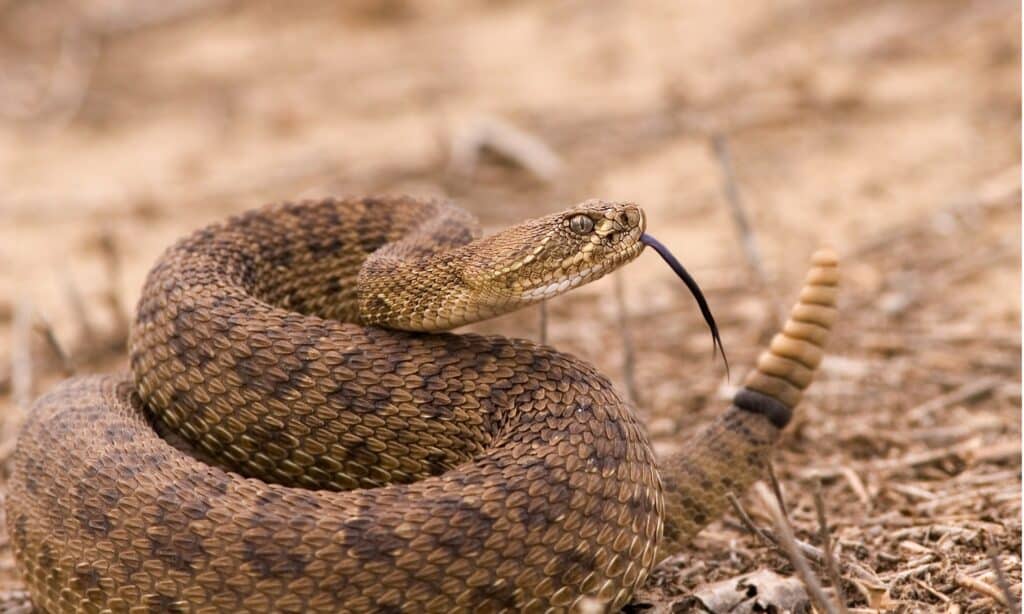
The rattles on this rattler’s tail can tell you know how old it is.
©iStock.com/SteveMcsweeny
This beautiful, heavy bodied pit viper lives around Lake Berryessa and points north, south, and east. It usually grows to about 39 inches, though at least one was 65 inches long. The ground color of the snake’s body ranges from gold to gray, tan, pink,s or bronze with a pattern of dark blotches edged in white. The color of the snake’s iris often matches that of their ground color. The tail is ringed, with the rings growing darker as they approach the end of the tail. The tail, of course, bears rattles. The snake rattles its tail to warn off aggressors. Some biologist give the snake the scientific name Crotalis viridis, while others call it C. oreganus.
Western Rattlesnake Behavior
The snakes uses the heat-sensing pits in its face to help it find prey, which includes birds, smaller mammals, reptiles, amphibians, and eggs. Hatchlings eat insects until they’re big enough to tackle larger prey such as mice or voles. The western rattler hunts during the cooler parts of the day, and if it is too hot during the day, it will hunt at night. When it’s in striking distance, it bites quickly and envenomate the prey. Despite being venomous, the western rattlesnake is still prey for raptors. Western rattlesnakes hibernate during the winter and can travel a very long way to find a suitable den.
Reproduction
Western rattlers give birth to live young. Females can be gravid for as long as 425 days after mating in the spring after emerging from hibernation. During that time, she doesn’t eat. She’ll give birth to between three and eight and sometimes as many as 15 babies in late summer. Males are ready to mate when they’re between two and four years old, and females are ready from between the ages of three and seven. They usually breed every other year. Western rattlesnakes live from 16 to 20 years, and their conservation status is least concern.
5. Sharp Tailed Snake

The spine on this snake’s tail is harmless to humans.
This snake gets its name because of the spine at the end of its tail. Biologists aren’t quite sure why the snake has this spine, though some think it’s to anchor the snake as it tries to subdue its prey, or even to hold its prey steady. The spine is harmless to humans, as is the rest of this nonvenomous snake.
What It Looks Like
The sharp-tailed snake grows from 12 to 18 inches long and has shiny grayish brown, brown, reddish brown or gray scales on top. Its ventral side has beautiful black, greenish or white crossbars. The snake is secretive and likes to hide under rocks, duff, and logs. During the hotter months it finds a burrow to hide in until the rains come, and sometimes snakes can be found together. If you dig it up by mistake, it may simply curl up in a ball. It eats slugs, which it holds firmly in its jaws with tiny, needle-sharp teeth. The snake is often the prey of birds, mammals, larger snakes, and even larger fish.
Reproduction
The sharp-tailed snake mates in the spring, and the female lays three to eight eggs in the summer, sometimes in a communal nest. The babies hatch in fall and are about 3 to 4 inches long.
6. Western Racer
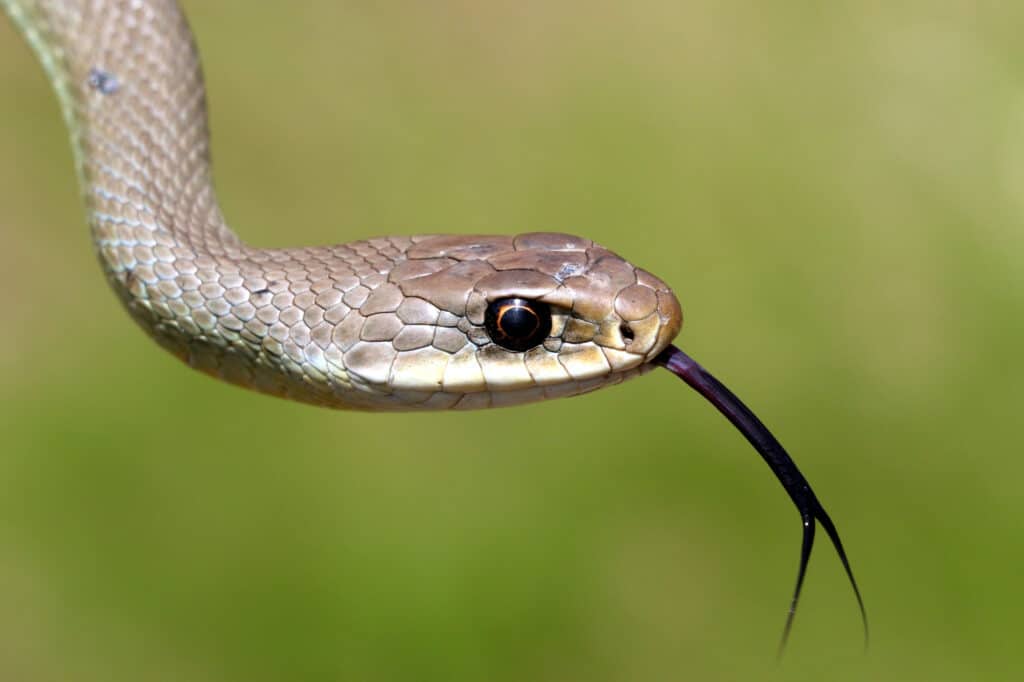
The round pupils of this western racer tells you that it’s nonvenomous.
©iStock.com/randimal
The western racer, Coluber constrictor mormon is also called the western yellow-bellied racer because of its yellow underside. It’s only found in the western United States, even though it’s a subspecies of C. constrictor, the eastern racer. Its dorsal colors are brown, olive-brown, gray, blue, or green. The scales are shiny and quite smooth, and the length of the snake ranges from 35 to 75 inches. Young snakes have gray, brown, or red blotches that fade as they get older. You can tell males from females because the male’s tail is longer and has a wider base, while the tail of the female tapers.
Western Racer Behavior
Despite its name, racers don’t move as quickly as they seem to. If disturbed, it hurries to a hiding place, and even climbs up a tree. If it can’t escape, the snake coils, vibrates its tail, and strikes. Though the western racer is nonvenomous, it can give you a bite deep enough to draw blood. If striking doesn’t stop a predator, the snake coils up, hides its head and writhes while it smears secretions all over itself. If it’s finally grabbed, it writhes and voids its bowels. It may writhe so violently that it breaks off its own tail.
What It Eats
The western racer has a varied diet, but despite its species name, it doesn’t constrict its prey but simply overpowers it. Prey includes insects, frogs, reptiles, including other snakes, rodents, squirrels, and small rabbits. In turn, the racer is eaten by canids, pet cats, and birds.
Reproduction
Western racers mate in spring, and in June or July the female finds a stump, log, or an old abandoned burrow and lays from three to 32 eggs. Sometimes females lay their eggs in a communal nest. The eggs hatch in late summer. Males are ready to breed when they’re one to two years old, while females are ready when they’re two to three years old. Western racers live to be around 10 years old, and their conservation status is least concern.
7. Whipsnake

Lake Berryessa provides the whipsnake with amphibious prey.
©Steve Schlaeger/Shutterstock.com
This common, nonvenomous snake belongs to the Masticophis genus, which has 11 species, some of which should be found around Lake Berryessa. One would be the striped whipsnake. This snake also likes to live around bodies of water, where it can hunt amphibians.
What a Whipsnake Looks Like
As their name suggests, whipsnakes are slender, whiplike, fast, and have smooth scales. They grow to between 36 and 72 inches long. On top, they’re gray, blue or dark brown. There are three lighter stripes of gray or white on each side, and one white stripe is attractively divided by a black line that can be solid or broken. The snake’s belly is whitish or yellow and turns to pink near its tail.
Behavior
The whipsnake is a diurnal snake and shelters beneath rocks, in burrows and even in shrubs or trees. It has a varied diet that includes fellow snakes, including rattlesnakes, lizards, birds, frogs, insects and small mammals such as mice or voles. Young whipsnakes eat insects such as cicadas until they’re large enough to subdue other animals. How the snake behaves when it’s confronted probably depends on the snake. Some will coil up and strike while others let themselves be picked up. It’s possible that an individual snake is aggressive at one time and passive at another.
Reproduction
Biologists don’t know much about the whipsnake’s breeding behavior, but they do know that females lay three to 12 eggs in spring or summer. These eggs hatch after about two to three months. Its conservation status is least concern.
8. California King Snake
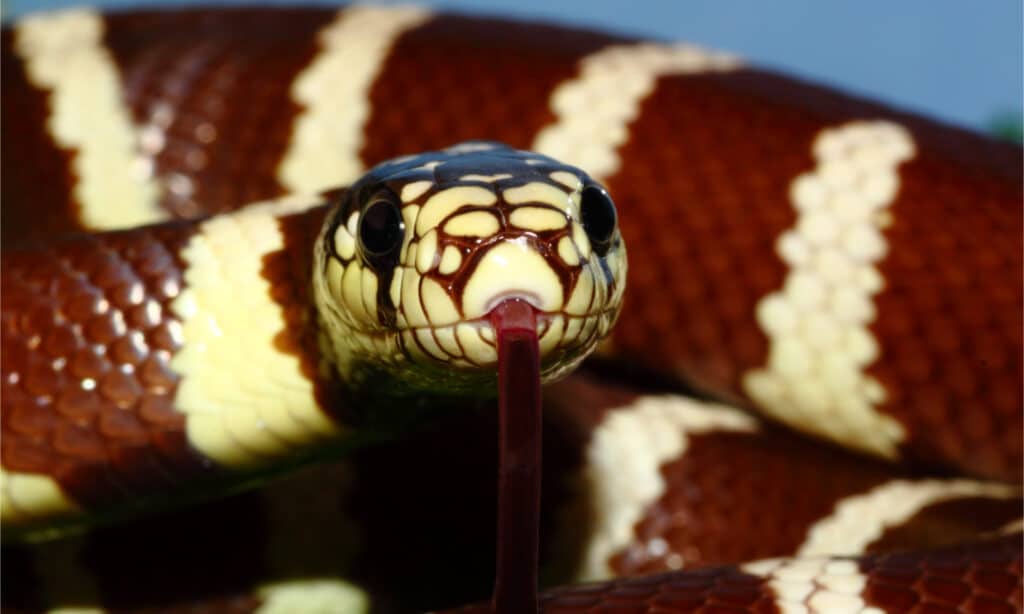
California mountain king snakes look like venomous coral snakes, but they’re harmless to people.
©MattiaATH/Shutterstock.com
The California mountain king snake looks very much like the venomous coral snake, but it is harmless to humans. However, it’s not harmless to the great variety of animals that make up its diet. This snake will tackle just about anything for a meal. If it’s small it will swallow it whole. If it’s large, the snake constricts it to death, then swallows it.
Prey includes lizards and their eggs, nesting birds and their eggs, and amphibians. It even eats other snakes, including venomous snakes such as the prairie rattler. The king snake’s brilliant coloring actually alerts birds to it. The birds attack it uselessly, and the snake simply follows them back to their nest.
What It Looks Like
Lampropeltis zonata ranges in length from 20 to 48 inches in length, with smooth, unkeeled scales. Its body is slender with black, white, yellow, or red bands. The red bands always have black borders, which tells the snake from the coral snake. The top of the snake’s head is black, while the throat and the chin are white. Another way to tell the king snake from the coral is that the band right after the head is white. The snake has at least seven subspecies, with slightly different patterns and colorations, especially when it comes to the red bands on the body. Because the differences can be subtle, it’s easier to determine the subspecies of king snake from where it lives.
Male and female king snakes are hard to tell apart, but males have more subcaudal scales and longer tails than females. Males also seem to be a little bit larger. The snake also has 11 to 13 teeth in each of its jaws.
Reproduction
The California mountain king snake breeds once a year from early to late spring, usually right after it wakes from hibernation. Females may skip a year. L. zonata is an egg laying snake, and the females lay their eggs from late spring to midsummer. Clutches range from two to 10 eggs, with the average number being seven. They incubate for about 62 days. Scientists aren’t sure if the eggs or hatchlings are taken care of by their mother. Nor are they sure when the snake reaches maturity or its lifespan in the wild. There was one captive kingsnake that lived for 26 years.
Where It May Be Found Around Lake Berryessa
The California mountain king snake can thrive in different habitats but you’ll probably find it in the woods and forests near the lake. The snake also needs to be near rocks and logs that it can bask on during the day and rest beneath at night. Habitat disruption, which includes clearing away these rocks and logs, puts the snake’s population under pressure. Yet, it’s conservation status is still least concern.
The photo featured at the top of this post is © Cedar Dobson/Shutterstock.com
Discover the "Monster" Snake 5X Bigger than an Anaconda
Every day A-Z Animals sends out some of the most incredible facts in the world from our free newsletter. Want to discover the 10 most beautiful snakes in the world, a "snake island" where you're never more than 3 feet from danger, or a "monster" snake 5X larger than an anaconda? Then sign up right now and you'll start receiving our daily newsletter absolutely free.
Thank you for reading! Have some feedback for us? Contact the AZ Animals editorial team.







